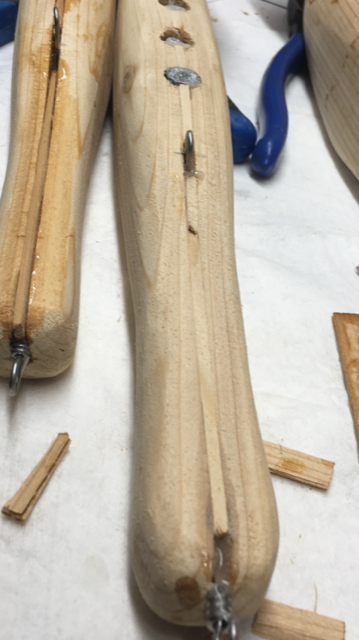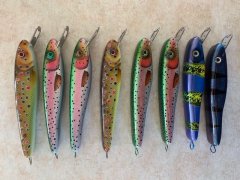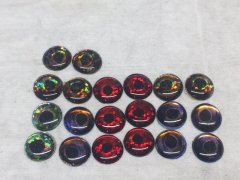-
Posts
462 -
Joined
-
Last visited
-
Days Won
28
Content Type
Profiles
Articles
TU Classifieds
Glossary
Website Links
Forums
Gallery
Store
Everything posted by eastman03
-
UKandy let us know how these test blanks work based on the differences of weight/hook placement. I'm making a side to side top water (prototype) and just guessed at where the best weight placement would be. I would think you'd aim for a level fall with the weight close to the center of the lure to act as a pivot kinda? But I really have no idea.
-
The wood shim is the way to go. I spent a few years messing with trying to fill the entire slot up with epoxy and it sucks. Sanding it out works, but it is hard not to nick the hook hangers Thru wire gets easier like anything you do multiple times. Don't settle. I like your passion for making a quality lure! To me that means through wire! Remember- you don't want to be remembered for this= (this is a 120$ Canadian headlock lure). I don't want to name names, but there ya go. Their lures work great and catch fish! And I love their epoxy finish and aluminum lip. But that's about where it ends. I fear I paid for a name, not a quality product.
-

New here, looking for some advice on big wire for bigger offshore lures
eastman03 replied to VanW's topic in Hard Baits
I've been meaning to make a bending tool like this as well. Anyone that makes lures will probably have most of their questions answered if they watch all of his videos! -
Sounds good! Yea, the top slot does suck for that reason. Drilling holes through to still allow the hook hangers to go through is a bit of an extra step. Let me know how the epoxying of the slot goes? I had trouble just using epoxy as it constantly ran out and ended up being a big mess, and I still had to fill the slot a bit more. What kind of epoxy are you using for that purpose? I have some lead sheets from old underground powerline (very old) that works well for ballast. I can cut it and it fits into the slot just right. That was a good find at work. The 1" belt sander would be super handy. I should look into getting one of those for sure! One other thing with installing the lip last. For a musky bait like that, it will probably take some abuse. I would recommend "pinning" it into the lure with something. Not many adhesives adhere well to polycarbonate. Having the lip pinned into the lure with some wire or small screws helps it take the abuse. On second look, what is that lip material made of? Anyway, looks good! Keep up informed of the progress.
-

New here, looking for some advice on big wire for bigger offshore lures
eastman03 replied to VanW's topic in Hard Baits
Welcome here first of all! I'm not totally familiar with the lure that you are making, but I use .062" wire in my muskie lures. I typically get my wire in the form of Stainless Steel Tig welding rod. Available almost everywhere, and comparatively cheap, and straight! This wire come is lots of sizes, so if you needed you can get .09" (3/32) as well or whatever you need. I have some of the .09 stuff for certain applications, and that stuff is hard to bend! The .062" stuff isn't too hard. Invest in some really good round nosed pliers (anything from KNIPEX is amazing). You can make jigs to help bend wire consistently if you are going to do the same lure over and over. -
Yea Vodkaman, my most recent lures that I just finished gluing up have the slot down the back. I leaves me more room as well for other things like rattles or weight. Sanding the slot smooth down the back helps without the hook hangers sticking down as well. I think both ways work though overall. I really like bondo too. Liquid superglue is expensive and i have to order it online. Bondo is cheap and available. Once I apply the bondo, i wait like 5 minutes or so till it is still in the curing stage, then using a sharp knife, I can easily remove most of the excess. I carves off like butter. Then once cured (only about another 5 min), you can sand it smooth. That saves me a lot of sanding.
-
Nice looks good! What are you planning on filing the slot with? That seems to be my most time consuming part. I "piping bag" epoxy into the slot, place the wire in, then use a stick to get epoxy on the side walls, then jam a piece of thin wood into the slot. Saves on filling the entire slot up with epoxy. If there are any gaps after (which there probably will be), i use bondo (or you could try the super glue/baking powder trick).
-
Yea, if it isn't right I for sure don't sell it. They go into my tackle box, or a close friend to use and test. If it has my name on it and I sell it, I want it to have good finish. Otherwise, you will be selling all your lures for discount, or other potential customers will see a sub par product. I like the idea of giving them to kids, but yea as a musky lure maker that might be tough lol. Honestly, I don't make/paint tons of lures, so I will usually take the messed up lures, and start over with it. Put a different paint job on it, or experiment with it. I have a bunch of lures on my "wall of shame" that will never go out to anyone lol. I agree with Big Epp, I'll test something out for anyone!
-
Lots of great advice here already! I like hearing that you want to make thru wire, as a musky lure maker I agree! As far a lips, i like lexan. Could probably use a coping saw to get close (or jig saw), they are cheap and can cut rounded edges. Then files/sander to finish the job. A belt sander with the small disc sander attached would be extremely helpful! I use mine a lot. Ideally in the future, a bandsaw for sure. Through wire methods all have their pros and cons. Cutting the lure right in half can make the final product more seamless, as you can dremel or use a knife to hide the wire or weight or rattles internally. But it is time consuming if you are trying to make many baits (probably not an issue at this point for ya). I would recommend just starting with two pieces of wood. Lightly super glue them together, carve the lure, then pry them apart and work on the interal stuff. Not to difficult. Drilling through is awesome. But drilling straight especially if your lures are 10"+ is very difficult. You can make a jig with some bushings to line up the hole if you are making the same lure over and over. But a slightly oversize drill bit can often get you close enough with practice. Drill through the block of wood before carving, then line your lure up with where the holes are, done. That way if the hole isn't perfect, you just line up your carving around it. My most often used, because of it's ease, is cutting a slot in the lure, then using epoxy to glue in a wire harness. I can be a bit of a mess trying to get the slot flush and perfect after that, but it works. Best idea, try them all! See what you like and what works. Write down how you made the lure, and where you put weights, and what worked! You can help yourself a lot down the road this way. Check out the tutorial section of the website, some good ideas in there. I made some lures with the hole through design, take a look. Welcome here! Musky Crankbait build - Hardbait How To - TackleUnderground.com
-
Hmmm I'm kinda curious myself, as I've only heard good things about the epoxy. I don't want to invest in some if it doesn't live up to the claims.
-
Thanks, yea totally use the idea. I'm definitely not the first one to do this! Honestly, I don't exactly make lures just to sell, but I made a few of these as gifts last year, and they were super popular. So I made more this year, and sold more than I could make before Christmas. You end up reaching a MASSIVE demographic of people who would never buy a lure, but know someone in their life who loves hunting/fishing. It makes a great gift for any "man cave".
-
Yea i've heard good things about it as well. Developed and made specifically for lure making. Not cheap! But better than ruining baits that's for sure. I've been tempted to order some myself. Thanks
-
I was hoping you would weigh in here a bit Vodkaman as far as a more scientific approach. From my experience building a crankbait, weight can act to dampen side to side action somewhat, but with a steady retrieve, or trolled, it seems like the lures i have experimented with did not change their depth significantly when weight was added or removed. Now when you have a neutral/ slow rising crankbait that can be paused and hung in the water column, that is a totally different thing (very useful). But it seems to me that the forces acting on the lip outweigh the force of gravity/buoyancy on the lure when it is in motion.
-
I've made several large deep diving lures that hit 25+ feet (obviously speed/how much line makes a different). These are trolling baits, 14" (plus 3" of lip) 12-16oz. I think the tow point makes a huge difference, how far up or down the lip or the body it is. It is the pivot of how much your lip can rotate "down" and pull the bait with it. Now I'm only speaking from making large lures, so I think there is more room for error or variances in weight and slight imperfections. Correct me if I'm wrong here, but how much does the actual weight of a deep diver make a difference. From my experience, i need to add enough ballast to make sure the lure sits in the water properly so the lure catches the water and dives. After that, more weight I don't think would make it dive deeper, I think the action and size of the lip would overtake anything that a bit more weight could interfere with. Again it may seem obvious, but my biggest thing with the baits working well, is making sure that lip is in there perfectly! Joint your wood, cut the lip slot while the wood is still square. Or make jigs to align the lips in the baits perfectly. You can correct some wander off to the side by bending the tow point slightly to one side or the other, but if the lip is not straight to the body in the x or z axis, the power of the lip will overtake anything else you can do at that point. Make a lip with several tow points when testing, so you can figure out what kind of action and dive curve you are looking for.
-
I don't know too much about the specs about wire. 308 304 etc.. I used .051" Malins lock wire for my first couple of lures, and it works just fine. It is meant to be bent and tie off (lock) pins and stuff into place, so honestly it was a tiny bit too "flexible" for me making musky lures. I also got annoyed of having to start with a coiled up piece of wire. It straightens out ok if you cut a piece and bend an eye into the one end, hook it around a nail or something solid, and just give the other end a few quick pulls. I have moved on to using Stainless steel .062" tig welding rod (i think that is 308). It is more available for myself, and I love starting with a straight piece of wire.
-
-
-
-
Great thread- from ethics to drilling holes. Cover just about everything! As far as making consistent repeatable lures down to .01" differences (wow!), you may have to reconsider using wood. I agree with Big Epp, using wood will always have some variables that we cant totally control. I have made batches of 12 crankbaits for a while now, and kept them the same to the best of my ability, and had one or two swim slightly different (sometimes better, sometimes worse). There are options like certain plastic deck boards (see other form posts) that would allow you to work as though it is wood, but take the variability of wood off the table. Just a thought, I like wood, and it suites me good enough. I have never been too concerned with tolerances of .01", but I make larger lures, and smaller batches, so I understand the need for repeatability. As far as ethics go, it is the eye of the beholder often, so it can be tough. I remember an old form post on muskiefirst when everyone was up in arms after a lure maker wanted to make a pin/clevis style lip, similar to a Headlock bait (which are very popular and expensive). Well everyone thrashed this poor fellow for wanting to emulate an idea of a bait. It wasn't until someone posted a lure that was from much before Headlock's time with the same pin/clevis lip design, it kinda quited down. I had one couple I guided order two different truly custom lures from me. I think his wife loved the idea of having a private Canadian lure maker, so she could show off a custom lure at bass tourneys and make other guys wonder where she got that? lol. That is what her husband said. haha She told me to charge more for my lures, there is a lot of people with a lot of money, and they think they are worth more if they pay more, and want it even more. haha Oh man, she was a strong confidant woman from Texas. I should have hired her to sell for me. Anyway, sorry for getting off topic lol.
-
Yup, I will use 5 minute epoxy, then fill in any imperfections or lead holes with superglue/baking soda, or car body filler (bondo). If you have a large deep slot and don't want to use tons of epoxy, I will epoxy in the wire (enough to cover the wire), then with some strips of wood, I will mix more epoxy and fill the slot with epoxy and the strips of wood making sure they are completely covered on all sides with the epoxy. Here is a pic of what I mean: Welcome here!
-
I've watched all of the Engineered anglers series on youtube, really good content. I like how he breaks it down and tests certain aspects like that. The lures that broke on me were bought lures. One was a very expensive 'high quality' lure, that was only about two years old, minimal use. Two other ones (like in the picture that i posted), were both suicks, probably my favorite musky lure of all time (i believe i have 5 in my tackle box, and another 12 on my 'retired lure' wall haha). I agree with you guys on everything. superglue screw eyes<epoxy screw eyes<epoxy screw eyes at an angle (like Engineered angler suggests)<dowels, with epoxy screw eyes, or a pinned system< Thru wire Again, you change line, get new rods, change hooks, split rings, all the other things that are replaceable to make sure they are in tip top shape, replacing a lure isn't always an option. When I bass, walleye, or even pike fish or pay 10$ for a lure, it makes sense that the lure will be made "strong enough" as it is more cost and time effective. But, a 100$ custom high quality 12" crank bait with screw in eyes. I mean it isn't even a question in my mind. All these methods have their merits, and new (like new fishing line, or rods) will be strong enough to handle. I also agree, i have used lures (like the suicks pictured) past their replacement date! No doubt about that. But I have been burned (as well as a few other musky anglers that i've talked to) by a big screw eye, in a expensive well made lure that wasn't that old. It isn't about one static test. It is about multiple uses, in water warm and freezing, from plus 30 to minus 10 (Celsius, I'm Canadian), getting banged off rocks, pulled through weeds, jerked/twisted/pulled snagged 1000 times and still bagging the 40 pounder when I need it to. Another thing specifically with large musky crankbaits is the thrashing they take when a fish goes in the net. Anyone who has bagged a big musky knows they sometimes thrash like crazy. I have had screw eyes turn 90 degrees from their epoxied point. I have also had thru wire bent sideways (often on the pulling eye). This can start to be a failure point in either of the lure, and it is something to be careful and watch out for. Often with crankbaits you have to tweak the pulling eye to get the crankbait to run true, and i really hate doing this with a 0.92 screw eye. Occasionally when you do this you 'crack' the glue going, basically leaving the pulling eye holding by friction alone.
-
I have heard and used lures with all those methods of installing hook hangers. The only one I really trust is wire thru. It isn't a question of how strong it is brand new, it is the question of time. We change our fishing line so it maintains the 20lb rating? We change split rings? We change hooks? We sharpen hooks?. We can't do the same with a lure hook hanger. When musky fishing, you may go an entire season before having the briefest encounter with a 40lb fish if you are lucky enough, and when you set the hook and all you feel is a expensive lure fly back at you it makes you question your life choices lol. Think of musky fishing more like sitting there and waiting for a month for a big giant buck. What weapon would you chose? To the casual hunter who wants shoot the first available deer and fill the freezer, it probably doesn't matter too much. You will have ample opportunity to get another one. But to get a musky of a lifetime, like a giant buck, you may never have a second chance. So you stack all the odds in your favor to never let that chance go to waste. To me, using a lure that I've had for a while, that has screw in eyes, is all part of those odds. And as you can see, I've played that game and lost. To anyone who has never been obsessed with musky fishing, it is a different game. Re-reading this I don't mean to be preachy lol. I just really really like musky fishing. And got into lure making after having 100$ lures screw eyes come out, or lips get loose etc.. it's like buying a corvette with crank windows. Screw eyes have no play IMO in high end quality musky lures.
-
Both of the baits I have had this happen to were wooden baits. I have had plastic baits like a Jake also break. That one seemed like it was never even built right. Some of the popular mass produced baits seem to have some manufactured defects so that would be a bit different.
-
Let us know how the lures turn out! It is a fun hobby for sure. Wow, you must have boated by my cabin basically every time. I have a small island just north of the powderpuff out past the mouth of Locke bay. If you know the area at all, all the locals call my island "Outhouse island" (that is the nice way of putting it). Or "S***house island" haha.










